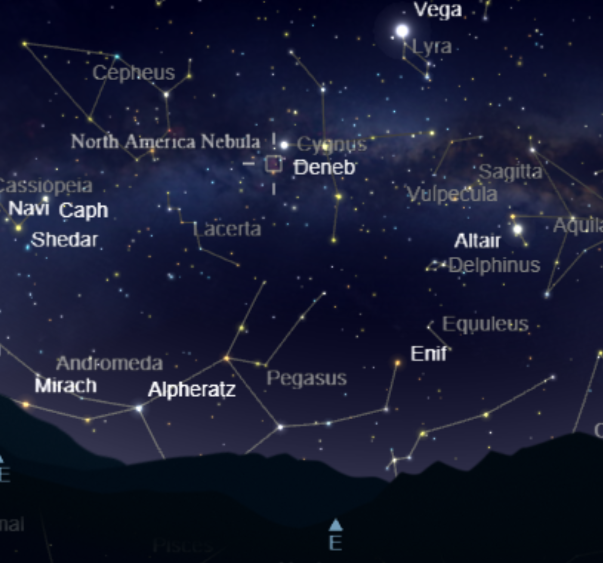NGC7000-North american Nebula
Empire, MI
07/21-22/25
NGC 7000 – The North America Nebula: A Stellar Landscape in Cygnus
Visible high in the eastern sky during the evening hours of summer, NGC 7000, more commonly known as the North America Nebula, is a vast emission nebula in the constellation Cygnus, located near the bright star Deneb—the tail of the swan and one of the stars in the Summer Triangle. This glowing cloud of ionized hydrogen gas spans an area more than four times the size of the full Moon and earns its name due to its striking resemblance to the shape of the North American continent in wide-field images. in this image, the continent is upside down from our perspective, with Mexico and Central America to the upper right, with the dark region in the upper center as the Gulf of Mexico, with Florida to its left.
Distance and Size
- Distance: Approximately 2,600 light-years from Earth
- Apparent Size: ~120 arcminutes x 100 arcminutes (2° x 1.5°)
- Actual Size: Roughly 90 light-years across
Structure and Features
NGC 7000 is part of a much larger star-forming complex that includes the Pelican Nebula (IC 5070), located just to the east and separated from NGC 7000 by a dense dark cloud of interstellar dust known as L935, or the “Gulf of Mexico” region in reference to the nebula’s familiar shape.
One of the most prominent features within NGC 7000 is the Cygnus Wall—a long, bright ridge of gas and dust marking a zone of intense star formation. This wall corresponds to the “Mexico and Central America” portion of the nebula’s outline and appears as a dense, glowing curve sculpted by the radiation and stellar winds from nearby massive stars. The Cygnus Wall is rich in young stellar objects, protostars, and dark Bok globules, making it a key region for studying the early stages of stellar evolution.
The bright “coastlines” of NGC 7000, including the Cygnus Wall, trace ionization fronts, where intense ultraviolet radiation heats and ionizes the surrounding hydrogen gas, creating the deep red Hα glow.
Ionizing Source
The primary star responsible for energizing NGC 7000 is believed to be the O-type star HD 199579, or possibly another massive, embedded star within the Cygnus OB2 association—one of the most massive star-forming regions in the Milky Way. This star is visible in the image on the left center. There are two bright stars in the middle of the nebula, HD 199579 is the Blue star. (refer to the map image. Marked as HR8023) It is truly a monster, radiating some 413,000 times the energy of our sun, with a surface temperature of ~45,000 degrees Kelvin. At 2400 light years away, our sun would only be visible in the most powerful of telescopes.
NGC 7000 is a stellar nursery, especially active along the Cygnus Wall and the denser regions bordering the dark dust lanes. Infrared and radio observations have revealed numerous protostars, Herbig-Haro objects, and regions of molecular outflows, all indicators of young, forming stars still embedded in their natal clouds.
Project Details
-
Empire, MI
-
ZWO FF65 telescope; FL = 416mm, f6.4, Pentax K3ii, iso500, 4 minute subs, 9h58m integration time




